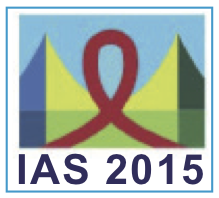Low dose boosted atazanavir is non-inferior to standard dose in Thai treatment optimisation study: LASA
1 August 2015. Related: Conference reports, Treatment strategies, IAS 8th Vancouver 2015.

Polly Clayden, HIV i-Base
Atazanvir/ritonavir (ATV/r) 200/100 mg is non-inferior ATV/r 300/100 mg according to results presented at AIDS 2015 by Torsak Bunupuradah on behalf of the LASA study group.
Dr Bunupuradah explained that the standard dose of ATV/r is associated with high exposure in Thai people in a previous study: median AUC 41 vs 72 h*mmg/L in qhite and Thai people respectively receiving ATV/r 300/100 mg; but AUC 42 h*mmg/L in Thai people receiving 200/100 mg.
For the LASA study, 559 people receiving boosted protease inhibitors (PIs) with viral load 50 copies/mL for at least 12 months were randomly assigned to receive ATV/r 200/100mg or ATV/r 300/100mg once daily with two NRTIs at 14 sites in Thailand.
Participants were assessed every 12 weeks until week 48. Virological failure was defined as confirmed viral load >200 copies/mL. The primary endpoint was the proportion of participants with viral load <200 copies/mL at 48 weeks. Non-inferiority was defined as the lower limit of the 95% confidence interval for the difference in viral failure above -10% by intention-to-treat (ITT) analysis at 48 weeks.
Of the randomised participants: 279 vs 280 received ATV 200/100 mg and 300 mg respectively. For ITT analysis (non-completer=failure/snapshot) 273 vs 277 participants were included and 259 vs 244 were included in the per protocol (PP) analysis, from the respective treatment arms.
At baseline, 85% of participants were receiving lopinavir/ritonavir. Mean age was 42 years old, weight 59 kg, CD4 539 cells/mm3, total bilirubin 0.85 mg/dL. They had received PIs for five years previously and approximately half of the participants were women.
At week 48, in ITT analysis, the proportions of participants receiving ATV/r 200/100 mg vs ATV/r 300 mg with viral load <200 copies/mL were: 97.1% vs 96.4% (95% CI: 0.68, -2.29 to 3.65). The respective proportions with <50 copies/mL were: 93.4% vs 91.7% (95% CI: 1.71, -2.67 to 6.09). In PP analysis the proportions with viral load < 200 copies/mL were 98.5% vs 99.2% (95% CI: -0.72, -2.6 to 1.16). In non-completer=failure (snapshot) analysis the proportions with viral load <200 copies/mL were 96% vs 91%, p=0.02, and <50 copies/mL were 92% vs 86%, p=0.03.
A higher proportion of participants receiving ATV/r 300/100mg arm discontinued treatment overall: 2.6% vs 7.6%, p=0.01. The proportion was also higher for discontinuation due to clinical jaundice: 0.4% vs 2.2%, p=0.06. Only one participant receiving ATV/r 200/100 mg developed resistance to ATV: 150L, V82A and L90M. This participant had a self-reported history of non-adherence.
At week 48, mean total bilirubin was 1.9 (SD +1.1) vs 2.2 (SD +1.2) mg/dL and proportions of participants with grade 3-4 hyperbilirubinemia (>3.12 mg/dL) were 17% vs 35%, in the ATV/r 200/100 mg vs ATV/r 300 mg arms respectively (both p<0.001). There was no difference in CD4, ALT, creatinine clearance, total cholesterol and triglycerides between treatment arms.
Based on the December 2014 antiretroviral price list at The Thai Red Cross Research Centre, the investigators calculated up to US$ 58 million savings over five years treating 20,000 people with the lower dose.
Comment
These results, including the cost analysis, make a compelling argument for lower dose ATV/r in Thailand.
Reference:
Bunupuradah T et al. Atazanavir/ritonavir 200/100 mg is non-inferior to atazanavir/ritonavir 300/100 mg in virologic suppressed HIV-infected Thai adults: a multicentre, randomized, open-label trial: LASA. 8th IAS Conference on HIV Pathogenesis, Treatment & Prevention.19-22 July 2015. Vancouver, BC, Canada. Oral abstract TUAB0101. Webcast:

